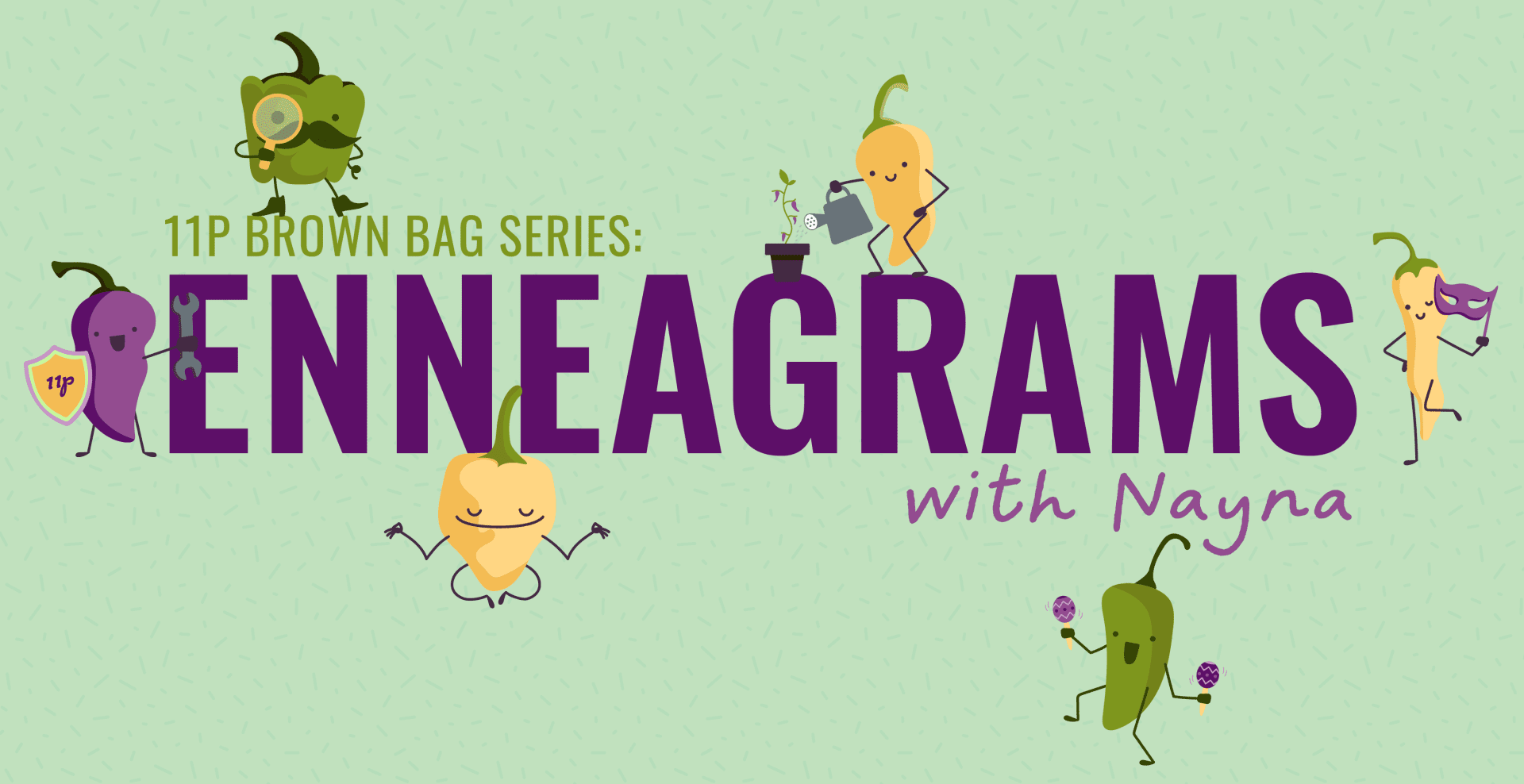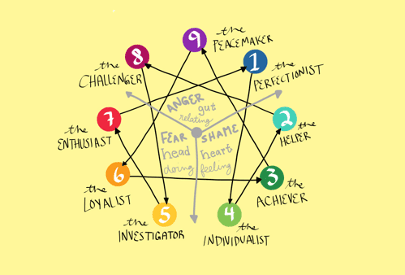
Are You My Type? Embracing the talents, traits and motivations of every Pepper.
The Sitch
Most people are familiar with the Myers-Briggs Type Indicator (MBTI) and can usually rattle off their four-letter “type” that represents their preferences across four dimensions of personality. A lesser number of individuals, however, have heard of or know their Enneagram Type. The Enneagram defines nine personality types, each represented by a number and archetype, and addresses the interconnectedness between each type. These simplified results are more relatable in comparison to Myers-Briggs, as some individuals feel pigeon-holed into specific characteristics that belong to “their” Myers-Briggs type whereas, realistically, we can – and should – all see ourselves in all personality types, even if one is most dominant and others take lesser forms.
The Enneagram Test is relatively quick and simple, and has, for so many of us Peppers anyway, turned out to be eerily accurate, both professionally and personally. Initially, charged with organizing an exercise for a Sprint Retrospective, I had our newly formed UX team take the test, reflect on the results independently and come to the table ready to discuss and divulge a little about ourselves. My hope was that we would be able to communicate better with one another, minimizing conflict and turning well-intentioned feedback into constructive criticism rather than a catalyst for conflict among strangers.
What came of the exercise far exceeded my hopes. So much, that I felt compelled to not only share the information gleaned from the Enneagram itself, but to also suggest to our Peppers how they too can leverage that information and forge truly synergistic relationships and high-performing teams. By the end of our sprint retrospective, our UX team had shared some, learned some, and even grown together some. Most importantly, we had a lot of fun during our exercise and came out of it stronger as a team. It’s been almost a year, and we still occasionally refer to our “types” in conversation, and learn new things about each other regularly.
The Skinny
The Enneagram describes patterns in how people interpret the world and manage their emotions. It describes nine personality types that are known through their number and associated archetype. The diagram shown below helps to illustrate how the types relate to one another, although that requires a much deeper dive than this initial exercise. Each of the nine types placed into one of three Enneagram ‘triads’ or ‘centers of intelligence‘ that indicate behavioral drivers: the Instinctive Center, the Feeling Center and the Thinking Center, which reveal how everyday experiences are filtered and how the personality types are motivated. Heart types (Two, Three and Four) depend on their emotional intelligence to understand their own reactions, connect with people on an empathic level, and have a dominant core emotion of shame. Head types (Five, Six and Seven) depend on their intellectual intelligence to navigate the world around them, reacting with analysis first, and have a dominant core emotion of fear. Body types (Eight, Nine and One) depend on their instinctual intelligence, or that “gut feeling” within them to make sense of things and have anger as a dominant core emotion. The Heart, Head and Body types connect to the world through feeling, doing, and relating, respectively.


The Deets
What follows is a very brief description of each type, with its number and archetype, just to touch on some of the most notable characteristics. In the next section, we’ll go over where to take the Enneagram for yourself, and some suggestions on how to incorporate an exercise like what our team engaged in.
Heart Types (Two, Three and Four)
Type Two: The Giver/Helper – Caring, positive, and empathic. Good at making personal connections and lifting others. Because they always put others first, they can struggle to understand or prioritize their own needs.
Type Three: The Achiever/Performer -Enthusiastic, highly motivated, and productive. Their desire for recognition and external positive reinforcement can lead them to lose sight of what they value as an individual.
Type Four: The Individualist/Romantic -Emotional idealists who value creativity, authenticity, and aesthetics. They are motivated by the meaning of their work and the people around them. Emotionally sensitive, Fours can take criticism too personally.
Head Types (Five, Six and Seven)
Type Five: The Investigator/The Observer – Self-reliant, perceptive, and analytical. Can be challenged with interpersonal relationships as they tend to live in their own heads.
Type Six: The Skeptic/Loyalist – Perceptive, loyal workers who focus on anticipating challenges and coming up with solutions. Their love for rules and safety can make them pessimistic or skeptical in certain situations.
Type Seven: The Enthusiast/Epicure – Optimistic, forward-thinking storytellers who don’t like to be limited to one thing at a time. They are less likely to acknowledge problems or give the appropriate depth of thought to a subject.
Body Types (Eight, Nine and One)
Type Eight: The Challenger/Protector – Fair, intense, and protective of their people. Their tendency to dominate a conversation can be intimidating. They are often bossy or abrasive when things don’t go their way.
Type Nine: The Peacemaker/Mediator – Balanced peacemakers who can see everyone’s point of view. Because they value peace and harmony, they may go out of their way to avoid conflict. They also have difficulty setting priorities and creating structure.
Type 1: The Perfectionist/Reformer – Hardworking, thorough and responsible. Prioritize doing things “the right way” over “the fast way,” which can sometimes affect productivity.
The Scoop
Here’s the breakdown of the exercise our team did. I think there are endless ways to expand on this, but as a starting point, just a general understanding of one another is perfect. In total, all the steps in the exercise below probably take less than an hour. I’d recommend each member of the team set aside some time to work through everything in one sitting when they have time to quietly focus on their own, and jot down some thoughts to share in your next meeting.
Step 1: To take the same Enneagram Type test that our team engaged in, have each team member set aside about 15 minutes and take the test on Truity : https://www.truity.com/test/enneagram-personality-test. Answer the questions as best you can, without overthinking, and just going with what your first instinct would be.
Step 2: Each person can then read up on their results here:
Step 3: Next, think about how you communicate. Specifically:
- What are some forms of communication are you good at?
- What can you work on?
- Think of a time in the recent past when communication broke down. What happened?
- Think of a time in the recent past when communication went well. What happened?
Step 4: Read this blog post about communication style and your enneagram type.
Step 5: Make some notes about the strengths and developmental areas suggested. Were there any consistencies with what you listed in step 3? Any surprises?
The Endgame
The process of being introspective within and of itself makes someone appreciate the nuances in personality of the people around them. However, when done in a context like this, taking the Enneagram Test and debriefing with your team after a little reflection can be helpful along the lines of establishing team cohesiveness. While appreciating the differences and strengths of each personality, team members also have a chance to consider how their personality types can work best together, leverage from each person’s strengths, and home in on developmental opportunities to create a more synergistic team.
An activity like this can be expanded upon in endless directions from team dynamics to coaching and collaboration, navigating conflict, and giving and receiving feedback, just to name a few.


Written by
Nayna Shrivastava
Certified Myers-Briggs practitioner. Scrabble Master. Home Improvement Queen.
